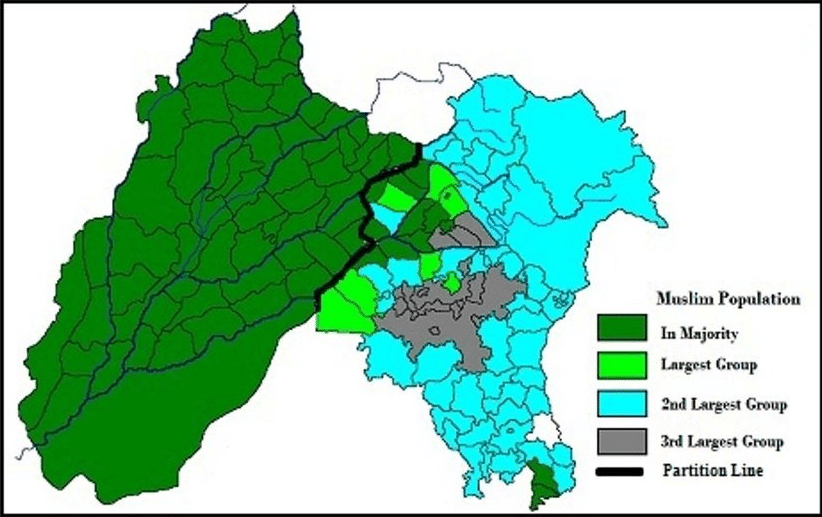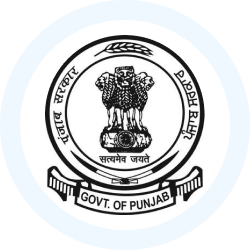Formation of the State 'Punjab' | Punjab State (PPSC) PSC: Preparation - PPSC PCS (Punjab) PDF Download
| Table of contents |

|
| Partition of Punjab |

|
| Historical Background of the Formation of Punjab State |

|
| Punjabi Suba Movement |

|
| Anandpur Sahib Resolution, 1973 |

|
Partition of Punjab
In February 1947, the British Government, led by Prime Minister Clement Attlee, decided to transfer power to Indians. To oversee this transition, Lord Mountbatten was appointed as Viceroy of India. On June 3, 1947, Mountbatten announced a plan for the future of India.

Key Points of Mountbatten's Plan
- Voting for Partition: Hindus and Muslims in the Legislative Assemblies of Punjab and Bengal would vote on whether to partition these provinces. If a simple majority of either group wanted partition, the provinces would be divided.
- Boundary Commission:. Boundary Commission would be established to delineate the borders in case of partition.
The announcement of this plan heightened political tensions. The Muslim League intensified its agitation for the partition of Bengal and Punjab. As a result of this pressure, the coalition government in Punjab, led by Malik Khizar Hayat Khan, resigned in March 1947. Eventually, both the Indian National Congress and the Muslim League agreed to the partition of Punjab, leading to the appointment of a Boundary Commission to determine the borders between West and East Punjab.
Historical Background of the Formation of Punjab State
Punjab Boundary Commission, 1947
- The Punjab Boundary Commission was established by the British Government on June 20, 1947, with Sir Cyril Radcliffe as its Chairman. The Commission included four Indian members: Justice Din Mohammad, Justice Mohammad Munir, Justice Mehar Chand Mahajan, and Justice Teja Singh.
- The Commission was tasked with determining the boundaries of Punjab based on religious majorities, dividing the region into areas dominated by Muslims and non-Muslims.
- Western Punjab, predominantly Muslim, was allocated to Pakistan, while Eastern Punjab, with a majority of Hindus and Sikhs, remained in India.
- The date for mass migration was set for August 16, 1947, by the Punjab Boundary Award, also known as the Radcliffe Award.
- Eastern Punjab included the Jalandhar and Ambala Divisions, comprising 13 districts out of the 29 in United Punjab. These districts were Amritsar, Gurdaspur, Jalandhar, Hoshiarpur, Ludhiana, Firozpur, Ambala, Karnal, Rohtak, Hisar, Gurgaon, Kangra, and Shimla.
- This area covered 37,357 square miles, with a population of about 1.27 crore (12.7 million).
- Initially, there was no major reorganization of districts in Eastern Punjab until 1956. During this time, the prefix "East" was dropped, and the region became simply known as "Punjab" instead of "East Punjab."
PEPSU (Patiala and East Punjab States Union)
Formation and Inauguration
- On July 15, 1948, the Patiala and East Punjab States Union (PEPSU) was officially inaugurated by Sardar Vallabh Bhai Patel.
- PEPSU was created by merging eight East Punjab princely states: Patiala, Nabha, Jind, Faridkot, Kapurthala, Kalsia, Nalagarh, and Malerkotla.
Early Governance
- The PEPSU government began functioning on August 20, 1948.
- Maharaja Yadvindra Singh of Patiala was appointed as the Governor, and Sardar Gian Singh Rarewala became the Chief Minister.
- Patiala was designated as the capital of the Union.
Merger with Punjab
- On December 29, 1953, the Government of India established the States Reorganisation Commission.
- The Commission recommended merging PEPSU with Punjab in its 1955 report.
- The merger took place on November 1, 1956.
Reorganisation of Punjab
- Northern districts of Punjab in the Himalayas were added to Himachal Pradesh.
- Southern areas of Punjab, where the Haryanvi dialect of Hindi was spoken, later formed the new state of Haryana in 1966.
- Jind and Narwana tehsils were transferred to Haryana.
- A new capital for Indian Punjab was established at Chandigarh.
- Shimla served as the temporary capital of Punjab until Chandigarh was completed in 1960.
Formation of Union Territory of Chandigarh
Chandigarh, situated at the base of the Shiwalik Hills, was meticulously planned by the renowned French architect Le Corbusier. The name "Chandigarh" is derived from the temple of Goddess Chandi, which is located in the same region.
In March 1948, the Government of Punjab, in collaboration with the Government of India, designated Chandigarh, specifically the area at the foothills of the Shiwaliks, as the new capital. Initially, Chandigarh served as the capital of Punjab from 1952 until 1966.
Following this period, Chandigarh was declared a Union Territory, coming under the direct control of the Central Government. The administration of Chandigarh was initially overseen by a Chief Commissioner until June 1, 1984, when the Governor of Punjab took over direct administration of the Union Territory.
Today, Chandigarh functions as the capital city for both Punjab and Haryana and is itself a Union Territory.
Basic Facts about Chandigarh
- Latitude: 30°44'14'' N
- Longitude: 76°47'14'' E
- Density (2011 Census): 9,252 persons per sq km
- Neighbouring States: Bordered by Punjab to the North, West, and South; Haryana to the East
- Total Area: 114 sq km
- Total Population (2011 Census): 1,055,450
- Sex Ratio (2011 Census): 818 females per thousand males
- Literacy Rate (2011 Census): 86.05%
Punjabi Suba Movement
In the 1950s, there was a strong desire among various linguistic groups in India for statehood, which prompted the formation of the States Reorganisation Commission in 1955. The Akali Dal, a political party in Punjab predominantly representing Sikhs, advocated for the creation of a Punjabi Suba, or Punjabi Province. While the Commission recommended the reorganisation of states in India based on linguistic homogeneity, it rejected the demand for a separate Punjabi-speaking state. Undeterred, the Akali Dal continued its agitation for the Punjabi Suba.
The Akal Takht played a crucial role in mobilising Sikhs to support this cause, and thousands were arrested for their peaceful demonstrations during the Punjabi Suba Movement. Despite the protests, Prime Minister Jawaharlal Nehru refused to accept the demand, stating he would not concede even at the risk of civil conflict. The movement, led by Master Tara Singh and Sant Fateh Singh, persisted until the government finally agreed to the demand in April 1966 under Prime Minister Indira Gandhi.
Reorganization of Punjab (Punjab Boundary Commission, 1966)
In April 1966, a three-member Punjab Boundary Commission was established, headed by Justice J.C. Shah, with members S. Dutt and M.M. Philips. Based on the Commission's recommendations, Punjab was divided on November 1, 1966, resulting in the creation of Haryana and Himachal Pradesh.
The southern part of Punjab, where the Haryanvi dialect of Hindi was spoken, became Haryana. The area speaking Pahari dialects merged into Himachal Pradesh. The remaining area, with a Punjabi majority, formed the new state of Punjab, excluding Chandigarh, which was a Union Territory.
Anandpur Sahib Resolution, 1973
The Central Government had not resolved some basic issues regarding the demand of the Punjabi Suba Movement. To address these issues, the Shiromani Akali Dal appointed a 12-member committee that submitted its report on October 16-17, 1973. This report became known as the Anandpur Sahib Resolution. The resolution included various demands such as:
- Transfer of Punjab-Speaking Areas: The resolution called for the transfer of Punjab-speaking and contiguous areas to Punjab.
- Decentralization of Powers: It aimed at decentralizing powers among states, limiting the Central Government's authority to defence, foreign affairs, posts and telegraphs, currency, and railways.
- Protection of Sikh Minorities: The needs of Sikh minorities living outside Punjab should be protected.
- All-India Gurdwara Act: The resolution demanded the enactment of an All-India Gurdwara Act to bring all historical gurdwaras in India under the control of the Shiromani Gurdwara Parbandhak Committee (SGPC).
- Access to Gurdwaras in Pakistan: Free access to the birthplace of Guru Nanak Dev Ji and other gurdwaras in Pakistan was requested.
- Reservation for Sikhs in Defence Services: The resolution called for recruitment of Sikhs in Defence Services.
- Increase in Land Holding Ceiling: The ceiling on land holdings should be raised from seventeen to thirty standard acres per family.
- Abolition of Intermediaries: The resolution demanded the abolition of intermediaries in land tenure.
- Fixing Agricultural Produce Prices: Prices for agricultural produce should be fixed based on the cost of production by the average farmer, determined by the State Government.
- Public Sector for Basic Industries: All basic industries should be brought under the public sector.
- Nationalisation of Consumer Industries: Consumer industries dealing with essential commodities should be nationalised.
- Minimum Wages for Industrial Labour: There should be need-based minimum wages for industrial labour.
- Review of Minimum Wages for Agricultural Labour: Minimum wages for agricultural labour should be reviewed regularly.
- Completion of Thein Dam and Power Plants: The completion of Thein Dam and the establishment of more power plants, including one based on atomic energy, was demanded.
- Transfer of Chandigarh: The federally administered city of Chandigarh should be transferred to Punjab.
- Second Language Status for Punjabi: Punjabi should be granted second language status in the neighbouring states of Himachal Pradesh, Rajasthan, Haryana, and Delhi.
Rajiv Longowal Accord
The Rajiv Longowal Accord, also known as the Punjab Accord or Memorandum of Settlement on Punjab, was signed on July 24, 1985, between then Prime Minister Rajiv Gandhi and Akali Dal President Sant Harcharan Singh Longowal. This agreement came after the Akali Dal's agitation for the unresolved demands of the Anandpur Sahib Resolution, 1973.
Some key points of the accord included:
- Compensation for families of innocent individuals killed during the agitation or any actions after August 1, 1982.
- Merit-based selection for the Indian Army, with all citizens having the right to enroll.
- Extension of the Rangnath Mishra Commission's jurisdiction regarding the 1984 Delhi riots to Bokaro and Kanpur.
- Rehabilitation and employment for those discharged from the Army for desertion.
- Implementation of the All-India Gurdwara Act for structured governance of Sikh shrines in India.
- Withdrawal of the Armed Forces (Special Powers) Act (AFSPA) notifications in Punjab, with special courts handling only cases related to waging war and hijacking, while other cases would go to ordinary courts.
- Transfer of Chandigarh to Punjab, despite the Shah Commission's recommendation for Haryana.
- Referral of the Centre-State relations issue in the Anandpur Sahib Resolution to the Sarkaria Commission.
- Assurance of existing or increased water shares from the Ravi-Beas system for Punjab, Haryana, and other states.
- Prime Minister's directive to state Chief Ministers to protect minority interests.
- Promotion of the Punjabi language by the Central Government.
The Akali Dal agreed to withdraw their agitation in response to the accord, but it ultimately failed as the government could not fulfill its promises, and Sant Harcharan Singh Longowal was assassinated by terrorists.
|
23 videos|50 docs|47 tests
|




















